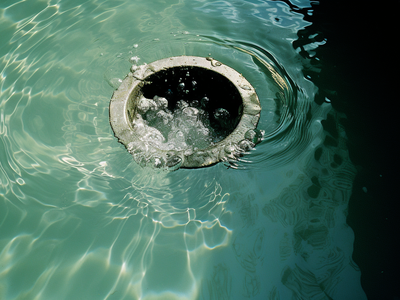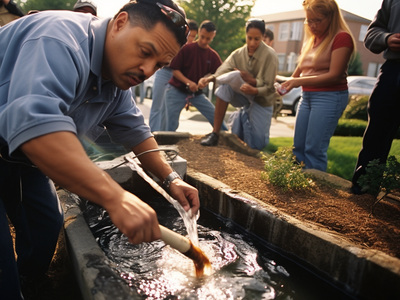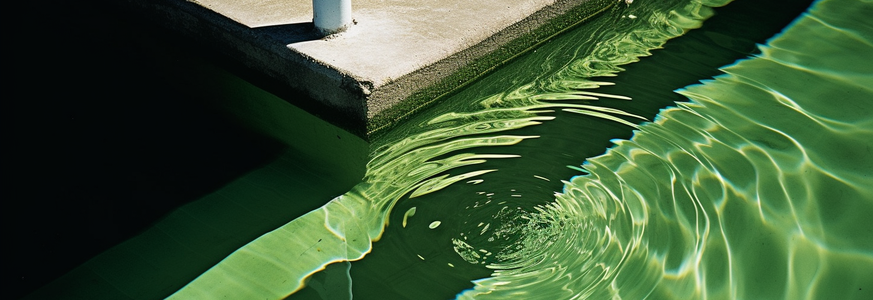Effectively dispose of dirty pool water
Practical tips and tricks, where the dirty water should go
Finding the appropriate destination for contaminated pool water can be of great importance to conscientious pool owners. As environmental responsibility and compliance with local regulations take center stage, navigating the various disposal options becomes increasingly important.
This article dives into the world of pool water disposal, highlighting the potential impacts of treated pool water and offering valuable insight into its sustainable use in landscaping. By following responsible guidelines, pool owners can protect both their pool water and the environment.
Pool water disposal options
 One way to dispose of contaminated pool water is to discharge it into a sanitary sewer or into the same sewers used for wastewater from other household sources. This method is convenient because it uses existing infrastructure and ensures proper disposal of the water.
One way to dispose of contaminated pool water is to discharge it into a sanitary sewer or into the same sewers used for wastewater from other household sources. This method is convenient because it uses existing infrastructure and ensures proper disposal of the water.
However, it is important to note that pool water containing high levels of chlorine or anti-algae chemicals should not be discharged into a street drain. These chemicals can be harmful to the environment and should be disposed of properly. It is recommended that local regulations and guidelines be consulted for specific instructions on the disposal of pool water.
Overall, discharging pool water to a sanitary sewer or similar channels is an appropriate option, provided precautions are taken to protect the environment.
The use of pool water in the garden
 Using treated pool water in the garden requires careful consideration of pH and removal of chlorine before use. Here are three important steps to follow when using pool water in your backyard:
Using treated pool water in the garden requires careful consideration of pH and removal of chlorine before use. Here are three important steps to follow when using pool water in your backyard:
-
Check the pH: Before using pool water in your garden, it is important to check the pH. The ideal pH range for most plants is between 6.0 and 7.5, so adjust the pH with pH boosters or lowers as needed.
-
Remove chlorine: Chlorine can be harmful to plants, so it's important to remove it from pool water before using it in your garden. Let the water sit for at least 24 hours to allow the chlorine to evaporate. Alternatively, you can use dechlorinating tablets or additives to neutralize the chlorine.
-
Water plants carefully: If you use pool water to water your plants, avoid overwatering. Pool water can contain high levels of salt and other chemicals, so it's best to use it sparingly and only when necessary.
Concerns about treated pool water
 When disposing of treated pool water, it is important to be aware of the potential hazards associated with the chemicals used in pool maintenance and water treatment. These chemicals can remain in the water even if it is disposed of properly. Biocides, which are commonly found in algaecides, can be particularly persistent and harmful. To emphasize the importance of proper disposal, refer to the following table:
When disposing of treated pool water, it is important to be aware of the potential hazards associated with the chemicals used in pool maintenance and water treatment. These chemicals can remain in the water even if it is disposed of properly. Biocides, which are commonly found in algaecides, can be particularly persistent and harmful. To emphasize the importance of proper disposal, refer to the following table:
| Hazardous Substances | Potential Risks |
|---|---|
| Chlorine | Skin and eye irritation, respiratory problems |
| Algaecides | Environmental pollution, damage to aquatic life |
| pH regulators | Corrosive, can damage pipes and equipment |
It is essential to prevent these chemicals from entering the environment and causing harm. Follow local regulations and guidelines for responsible disposal of pool water to protect both human health and the ecosystem.
Drain the pool
 To efficiently remove the remaining water from the pool, invest in a proper pump to speed up the draining process. A pump can remove the water at the bottom of the pool and prevent standing water from forming, which can lead to potential problems.
To efficiently remove the remaining water from the pool, invest in a proper pump to speed up the draining process. A pump can remove the water at the bottom of the pool and prevent standing water from forming, which can lead to potential problems.
Here are three benefits of using a pump to remove pool water:
-
Faster draining: A pump can significantly reduce the time it takes to remove water from the pool. It can pump the water out quickly and efficiently, allowing you to complete the draining process in less time.
-
Protection from damage: If water is left in the pool for an extended period of time, it can cause damage to the pool structure and equipment. By using a pump to quickly remove the water, you can avoid potentially costly repairs.
-
Ease of Use: Most pumps designed to remove pool water are user-friendly and require minimal effort to operate. They come with clear instructions and are designed to make the draining process as simple as possible.
Investing in a proper pool water removal pump can save you time, prevent damage and make the draining process hassle-free.
Other considerations
It's important to follow local regulations and guidelines for proper pool water disposal to protect the environment. There are additional considerations to keep in mind when disposing of pool water. Test strips are not reliable for determining pool water chemical contamination levels, so it is important to follow recommended guidelines. Aim for a chlorine-free water level of 0.05 mg/l when disposing of pool water. During regular pool operation, the chlorine concentration should be at least 0.2 mg/l. Proper draining of the pool is critical to avoid standing water and potential problems. Look for guidance in local regulations and guidelines for proper disposal of pool water and dispose of it responsibly to protect the environment.
Drain the pool properly
Efficient removal of the remaining water at the bottom of the pool can be achieved by using a suction pump to speed up the draining process. This essential equipment helps ensure that no standing water is left behind and potential problems are prevented.
Here are three reasons why using a suction pump is beneficial:
-
Time Savings: a suction pump significantly reduces the time it takes to drain the pool, allowing you to move on to other tasks faster.
-
Thorough Removal: By effectively removing water from the bottom, a suction pump helps prevent the buildup of dirt, debris and algae.
-
Prevents damage: Leaving water in the pool can lead to structural damage and costly repairs. By using a suction pump, you can avoid these potential problems and maintain the integrity of your pool.
Investing in a proper suction pump is a smart decision for efficient and effective pool water removal.
Test the pool water for chemical contaminants.
 Determining the chemical contamination level of pool water is critical for safety and proper disposal. Testing pool water for chemical contamination involves analyzing various factors such as pH, chlorine concentration and the presence of other contaminants.
Determining the chemical contamination level of pool water is critical for safety and proper disposal. Testing pool water for chemical contamination involves analyzing various factors such as pH, chlorine concentration and the presence of other contaminants.
The pH should be in the recommended range of 7.2 to 7.6 to ensure that the water is balanced and safe.
Chlorine concentration is an important factor in preventing the growth of bacteria and algae, but excessive concentrations can be harmful. It is important to regularly test and maintain proper chlorine levels in pool water.
In addition, it is important to test for the presence of other contaminants such as metals, bacteria and organics to ensure the water is free of harmful substances.
Responsible guidelines for disposing of pool water.
 When disposing of pool water, it's important to follow responsible guidelines to protect the environment and prevent potential harm. Here are three important considerations to keep in mind:
When disposing of pool water, it's important to follow responsible guidelines to protect the environment and prevent potential harm. Here are three important considerations to keep in mind:
-
Disposal options: Pool water can be drained into a sanitary sewer or into the same sewers as water from dishwashers, showers or toilets. The most convenient option is often to drain the water into a sink in the basement. However, it is important not to drain water with high levels of chlorine or anti-algae chemicals into a street drain.
-
Using pool water in the garden: pool water can be reused for watering plants or the lawn in your own garden. However, make sure the water is not too acidic or alkaline, as it can harm plants. In addition, chlorine should be completely removed from the water before it is used in the garden. Let the untreated pool water sit for two weeks to make sure it is safe for plants.
-
Concerns about treated pool water: even if properly disposed of, pool water is never completely safe. Chemicals used in pool maintenance and water treatment can remain in the water for weeks. It is important to prevent these chemicals from entering the environment, especially biocides found in algaecides, as they can be persistent and harmful.
More articles that might interest you
,format(png)/advert/cropped_2_ad_img_24rPU.jpg)
,format(png)/advert/cropped_2_ad_letterbox_8L7uS.jpg)
,format(png)/advert/ad-mUp-pizza-alfa.jpg)
,format(png)/advert/ad-lsK-Ploetzliche-Fliegeninvasion.jpg)
,no_upscale(),format(png)/prod/4/7/8/imp_1_478612.jpg)
,no_upscale(),format(png)/prod/4/7/8/imp_1_478653.jpg)
,no_upscale(),format(png)/prod/4/7/8/imp_1_478977.jpg)
,no_upscale(),format(png)/prod/4/7/8/imp_1_478635.jpg)
,no_upscale(),format(png)/prod/1/8/4/bimg_184842_go_3718074.jpg)
,no_upscale(),format(png)/prod/4/8/3/bimg_483325_30855328_7458473442.jpeg)
,format(png)/advert/cropped_2_ad_ticks_gcLzL.jpg)
,format(png)/advert/ad-GVN-fruehling-blumen.jpg)
,no_upscale(),format(png)/prod/4/7/8/imp_1_478978.jpg)
,no_upscale(),format(png)/prod/4/7/8/bimg_478417_102152.jpg)
,no_upscale(),format(png)/prod/4/7/8/bimg_478520_30855397_0093870344.jpeg)
,no_upscale(),format(png)/prod/4/8/0/bimg_480937_104413.jpg)
,no_upscale(),format(png)/prod/5/2/7/imp_1_527695.jpg)
,no_upscale(),format(png)/prod/5/2/5/imp_1_525430.jpg)